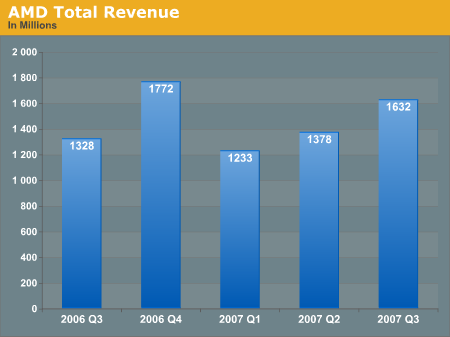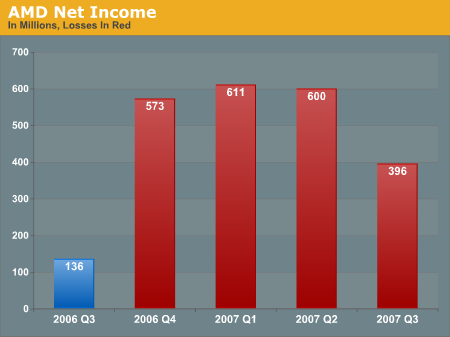The Business of Technology: AMD Q3 2007
by Ryan Smith on November 2, 2007 1:00 PM EST- Posted in
- Bulldozer
AMD By The Numbers
As always, we'll start this Business of Technology article with a look at AMD's stock price, a solid gauge of their overall health.

5 year stock history, courtesy of Yahoo! Finance
In spite of AMD's current situation, the stock has still done worse over the 5 year period, something not hard to imagine given the company's status of often hanging on by a thread. Their stock is still up almost three-fold compared to their lowest point prior to the launch of the K8. Going by their stock alone, AMD would appear to still have some breathing room should the fall further.
However as K8 sales set up AMD for a period of strong business growth and high stock prices, it has also set very high expectations for AMD that they have not been able to meet. The stock has fallen nearly 75% since its 5 year peak, and nearly 50% in the last year. The price drop represents both a dissatisfaction from Wall Street on AMD's future outlook, and a punishment for losing so much money over the last year.
How much has AMD lost, and how does that compare to their total revenue?


Because AMD acquired ATI in Q4 2006, we do not have completely comparable data for Q3 of 2006. The change in revenue between the two Q3s as a result is not solely revenue growth, but is rather a combination of that and the addition of ATI's products to AMD's business.
All told, the total revenue situation is actually good for AMD. In spite of the fierce competition with Intel and NVIDIA, their total revenue after removing their graphics revenue is still up a bit. Furthermore in this quarter they managed to beat Wall Street's rather pessimistic projections for revenue, thanks to overall processor sales that were above those expectations. AMD's price war with Intel has allowed them to keep their chips selling well (prices aside) while the Barcelona launch in September further boosted revenue.
Profits are less rosy however. The higher revenue has offset what was expected to be worse losses in Q3, but it wasn't nearly enough to move AMD close to profitability. Since their dip began, AMD has lost over 2 billion dollars on revenues of 6 billion; or in other words spending about $4 for every $3 of revenue. It's sufficient to say that this isn't something AMD can keep up, but for now their losses are lessoning.
So what have they been losing so much money on? Contrary to popular belief, this isn't solely due to price wars with Intel and NVIDIA, which is very good news for the company. We'll take a look at the segment breakdown to explain why this is.
| Revenue/Net Income By Business Group (In Millions, Losses In Brackets) | ||||
| Q3 2007 | Q2 2007 | Q1 2007 | Q4 2006 | |
| Computing | 1283/(112) | 1098/(258) | 918/(321) | 1486/65 |
| Graphics | 252/(3) | 195/(50) | 197/(35) | 166/(27) |
| Consumer Electronics | 97/(3) | 85/(22) | 118/(4) | 120/20 |
| All Other | 0/(108) | 0/(127) | 0/(144) | 1/(587) |
| . | ||||
Overall AMD is losing money on all of its major businesses, but their consumer electronics and graphics divisions are losing comparatively little money (so little in fact that they may as well be break-even), it's the processor and "other" segments that are the real money losers. For the processor segment in particular, AMD is not losing any money directly from chip manufacturing in spite of the price war, it's only after additional costs such as R&D are factored in that the segment is losing money.
The segment eventually needs to pay for its R&D, but to be losing money now, on the eve of the rest of the K10 launch, isn't a bad place to be. Furthermore AMD has managed to improve its gross margin (the percentage of revenue after the cost of goods) on its product range from a particularly low 33% to a stronger 41% between Q2 and Q3. A low gross margin had been an important factor in contributing to the processor segment's losses, so improving it is the biggest step to digging that segment out of the red.
Next, when we take a look at the "other" segment we can begin to understand where AMD is really losing much of its money. "Other" isn't a segment of real products, but rather the segment where AMD categorizes all expenses that don't fall in to other segments; this includes acquisition expenses, stock compensation expenses, and profit sharing. As it turns out, most of the $108 million that was lost was due to the ATI acquisition, which AMD is still paying for. The costs of the acquisition have set AMD back by $256 million so far this year. But (and this is the good news) these costs will be coming to an end soon. The ATI acquisition hasn't been the only thing pulling AMD down, but it's also a temporary cost that will be coming to an end on its own.
There is one final money pit for AMD however that can't be buoyed up by any good news at the moment, and that's debt. AMD has never been in a position or a desire to be completely debt-free, but right now they're swimming in it. AMD needed to borrow money in the first place to be able to buy ATI, but this has been further compounded by their losses. AMD spent nearly $100 million just on interest charges in Q3, and this has been growing steadily since they started posting their latest series of losses.
To give you an idea of what kind of debt AMD is in, we have the assets & liability numbers from both Q3 2006 and Q3 2007. In Q3 2006, AMD held nearly $8.4 billion in total assets and held $689 million in actual debt among $3.4 billion in total liabilities. In Q3 2007 they held nearly $13 billion in total assets (mostly from the ATI acquisition) but held $8.8 billion in total liabilities, $5.3 billion of which is debt. The fact of the matter is that between absorbing ATI's debt and adding to their own, AMD has racked up nearly $5 billion in debt in the last year. It goes without saying that this is very, very bad.
In closing on the subject of business, there has been a lot of concern if AMD can stay solvent for much longer. Looking at the numbers, rumors of AMD's impending death are a bit exaggerated. Barring any outside influences such as their own acquisition, AMD still has time left, but that time depends on what their losses are like. If AMD curbs their losses (and we expect this to be the case as things like the ATI acquisition come to an end) we're looking at a lot of time - AMD will be sound well in to release of the Bulldozer core in the future. But if they really want to turn things around they need to bring their processor and graphics segments to profitability, which as we'll see in our discussion on their technology, is a tall order that can be filled, but will be a challenge to do so.
In the mean time we can't ignore the effect that the ATI acquisition has had on AMD. It's not the cause of all of their woes, but it is the cause of a lot of them. We hope for AMD's sake that they're right about the GPU and CPU merging, because this entire endeavor will have been a significant drain on the company if Fusion and its derivatives don't pan out like AMD wants them to.










27 Comments
View All Comments
drpepper128 - Friday, November 2, 2007 - link
In the Netburst days Intel designed their chips from the desktop and then scaled them into the server market. At one point they also used their desktop chip to create a new laptop series of processors. As it turned out the competition with AMD proved that creating a server chip to a desktop chip was superior, but AMD still couldn’t compete well in laptop market because of Intel’s superior design. It turned out that with the power to performance ratio being important Intel’s laptop design was strong in more than just the laptop market. Intel consolidated their designs into one and made it go from the laptop to the desktop and then again to the server. This method has put Intel on top. AMD on the other hand has still not changed its ways except they now have a new team working on a laptop chip. One could say they have learned from Intel, but I believe they haven’t learned enough.In the article it says that AMD’s biggest loss is R&D and with two teams now designing chips this is horrible. Can AMD support two teams? Actually they have three teams if you think about graphics. I believe they should combine their processor teams into a mobile design and then work their way up much like Intel. Then there is the graphics. AMD eventually wants to combine the CPU and the GPU which I believe is a brilliant idea. When this happens the consolidation should increase profits. How can AMD not consolidate? Haven’t they learned the lessons from Intel and their own plans from graphics?
One last thing, I think AMD should also work on integrating more and more features of the chipset into their processor, not just the memory controller.
SigmundEXactos - Thursday, November 1, 2007 - link
10 years of AMD processors (since the K6) and 7 years of ATI (the original Radeon All-In-Wonder)....to be replaced by the end of the year with Penryn quad core & 8800GT.Will AMD go the way of NumberNine, Matrox, Centaur, and Cyrix?
Griswold - Saturday, November 3, 2007 - link
If you dont know what to post, dont post. Matrox is still alive an kicking, just in your typical gaming market.MrEMan - Sunday, November 4, 2007 - link
If I recall correctly the Cyrix CPUs were sold off by National Semiconductor to VIA, which for the most part is no where to be seen these days.Roy2001 - Monday, November 5, 2007 - link
If I recall correctly the Cyrix CPUs were sold off by National Semiconductor to VIA, which for the most part is no where to be seen these days.------------------------------------------------------------------
No, VIA's lower power CPU is actually based on IDT(Centaur)'s Winchip technology, not the crappy Cyrix architecture.
MrEMan - Monday, November 5, 2007 - link
Via Ready To Buy Cyrixhttp://www.crn.com/it-channel/18804994">http://www.crn.com/it-channel/18804994
Did the deal not materialize?
Roy2001 - Monday, November 5, 2007 - link
Via Ready To Buy Cyrix ...Did the deal not materialize?-----------------------------------------------------------
Via bought both Cyrix and Centaur division of IDT at bargain price mainly for legal purpose. However, winchip has "the small die size and low power-usage" (from wiki). New Via C7 CPU is more like a die/process shrinked Winchip, refer to Via's Centaur webpage: http://www.centtech.com/">http://www.centtech.com/
Calin - Monday, November 5, 2007 - link
Maybe the VIA current line of processors? C7 and the like, for use in ultra low power devicesdefter - Saturday, November 3, 2007 - link
Sure and now they have 0.1% marketshare:http://www.xbitlabs.com/news/video/display/2007102...">http://www.xbitlabs.com/news/video/display/2007102...
I wouldn't call that "alive and kicking". Maybe "barely alive" would be a better term.
Griswold - Saturday, November 3, 2007 - link
*just not in your typical gaming market - of course.